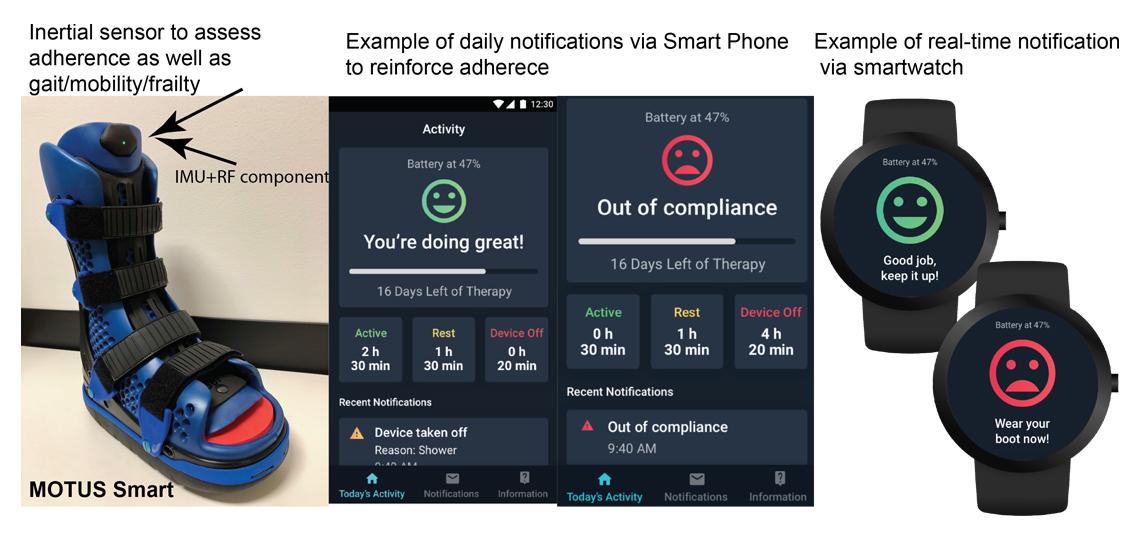
Improving the science of adherence reinforcement and safe mobility in people with diabetic foot ulcers using smart offloading
This R01 study plans to improve process of care by improving current gaps in reinforcement of adherence to protective offloading of limb-threatening and life-limiting diabetic foot ulcers (DFU) and better understanding the association between dosage of physical activity and wound healing
Funding: NIH R01DK124789
Collaborators: Bijan Najafi (PI), David Armstrong (Contact PI), Catherine Park (postdoc), Ram Mishra (Postdoc), and University of Southern California
IUCRC Phase I Baylor College of Medicine: Center to Stream Healthcare In Place (C2SHIP)

The Center to Stream Healthcare In Place (C2SHIP) unites the best minds in academic medicine and bioengineering with leaders in biomedical industry to research, develop and promote in-place care technologies for fertilizing a patient engagement ecosystem.
Funding: NSF 2052514
Collaborators: Bijan Najafi (Center Co-Director), Mark Kunik (Co-PI), Anand Naik (Co-PI), Michelle Patriquin (Co-PI), and joint partnership with University of Arizona, Caltech, and University of Southern California
Care4AD: A Comprehensive Care Coordination and Management Platform for Alzheimer’s Disease and Related Dementias

This NIH SBIR Fast Track project aims to design and commercialize a comprehensive care coordination and management platform that assist caregivers to effectively coordinate, manage, and improve dementia care.
Funding: NIH 1R44AG066360-01A1
Collaborators: Bijan Najafi (PI), Ashkan Vaziri (Contact-PI), Jan Linsay (Key Investigator), Ram Mishra (Postdoc), Catherine Park (Postdoc), Anmol Momin (Research coordinator), Nesreen El-Refaei (Research Coordinator), and Biosensics LLC
If interested, please call (713) 798-7470 or email ResearchInAging@bcm.edu.
Wearable Device for Automatic Delivery of Naloxone during Respiratory Arrest due to Opioid Overdose
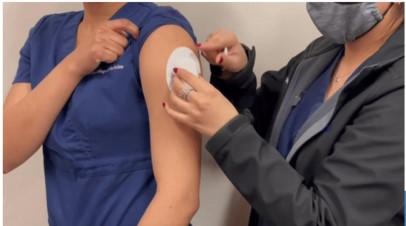
This NIH-SBIR Phase I aims to develop a novel wearable device that automatically detects respiratory arrest due to overdose and automatically delivers naloxone to save the life of a person who is overdosing from narcotics.
Funding: NIH 1R43DA049622-01
Collaborators: Bijan Najafi (Site-PI), Ashkan Vaziri (Contact-PI), Ram Mishra (Postdoc), Catherine Park (Postdoc), Anmol Momin (Research coordinator), Nesreen El-Refaei (Research Coordinator), Michael E. DeBAkey Veterans Affairs Medical Center, and Biosensics LLC
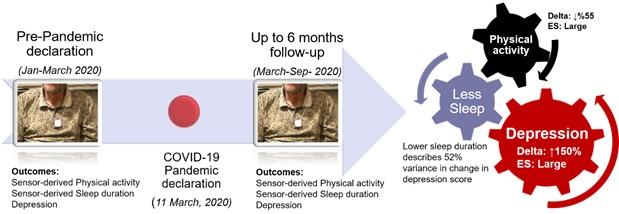
Impact of COVID-19 Pandemic on mental and physical health of older adults
The coronavirus disease 2019 (COVID-19) pandemic has exacted great illness, death, distress, and unprecedented restrictions on our society. Older adults are at high risk for developing serious complications from COVID-19 and have been recommended to follow strict guidelines to minimize the risk of exposure during the current pandemic. The resulting social isolation can have a significant negative impact on the physical and mental health of older adults, the extent of which is not completely known at this time. Understanding these effects can help mitigate the negative effects of social isolation caused by the pandemic and prevent long-lasting negative impacts on older adults’ health and wellbeing post-pandemic. To address the gap, we leveraged an ongoing study initiated prior to the pandemic. More specifically, we recruited a cohort of community dwelling older adults in which the patterns of physical activities and sleep were remotely monitored using a pendant sensor. When the pandemic was declared on 11 March 2020, we continued to follow-up with these participants up to 6 months post-pandemic, allowing us to objectively determine the pandemic’s effect on physical activities and sleep pattern.
Funding: NIH 2SB1AG032748-06
Collaborators: Bijan Najafi (PI), Ram kinker Mishra (Postdoc), Anmol Momin (AM), Mark Kunik (Key Investigator), Aanand Naik (Key Investigator), Michele York (Key Investigator), and Biosensics LLC.
Daily use of electrical stimulation therapy to prevent ICU acquired weakness in critically ill patients with COVID-19

Prolonged immobilization, associated comorbidities, and the use of glucocorticoids/paralytics may lead to intensive care-acquired weakness (ICUAW) among COVID-19 critically ill patients. Electrical stimulation (E-Stim) has shown to preserve muscle activity and strength, may offering a unique treatment to prevent ICUAW in this population. The purpose of this study is to examine the effectiveness, feasibility and acceptability of E-Stim to prevent ICUAW in critically ill COVID-19 patients
Funding: AVAZZIA Inc
Collaborators: Bijan Najafi Ph.D. (PI), Alejandro Zulbaran-Rojas (Research Associate), Mishra Ram (Postdoc), Naima Rodriguez (Research Coordinator), James Herlihy (Key Investigator), Muhammad Siddique (Key Investigator), and Baylor St Luck’s Medical Center - ICU team
ActivePERS: Portable Device for Telecare Monitoring of Elderly People
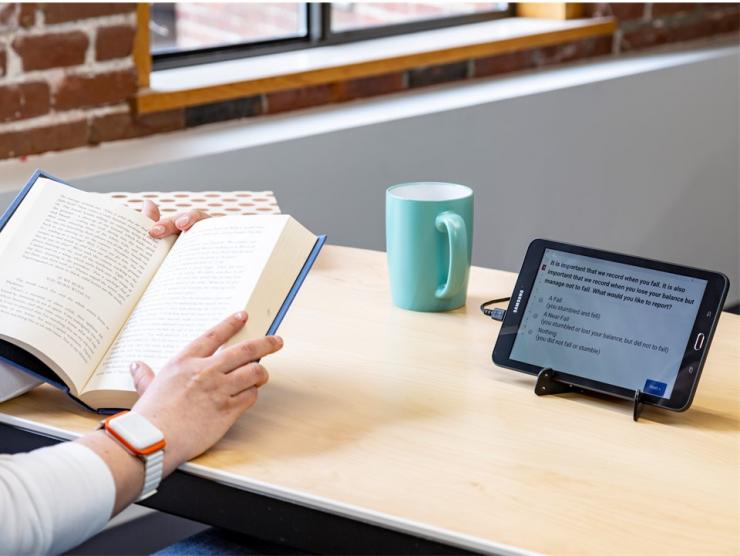
The purpose of this study is to have the widespread adoption of a remote home-based system (ActivePERS) by: modifying industrial design to support scale up, develop an in-home base station to receive fall alerts and place outgoing emergency calls, and determine the sensitivity of fall detection to predict the validity of the fall risk assessment. Cognitively impaired elderly subjects’ physical activity/falls are monitored through ActivePERS over a 12-month period on a daily basis. An ActivePERS wrist sensor and neck pendant sensor, and a tablet PC is provided to the subjects at the beginning of the study. The tablet is used to verify basic information about detected falls. If the sensor detects a fall, a signal will be wirelessly sent to the tablet. When this occurs, the tablet will display a simple message indicating the date and time the fall was detected. We hope that the dataset collected during this study will help develop a fall detection algorithm for a medical alert device that is worn on the wrist, and is similar to the datasets we have collected to develop and validate fall detection and fall risk assessment algorithms for the pendant form factor.
Funding: NIH 3SB1AG032748-06S1
Collaborators: Bijan Najafi Ph.D. (PI), George E. Taffet M.D. (Co-Investigator), Michele York (Co-Investigator), Ram kinker Mishra Ph.D. (Postdoc), Anmol Momin (Research Coordinator), Ilse Torres M.D. (Research Coordinator), and Biosensics LLC

An Innovative Platform for Objective Monitoring of Instrumental Activities of Daily Living
Assessment of Instrumental Activities of Daily Living (IADL) including cooking, shopping, and managing medication is essential for timely diagnosis of dementia, monitoring disease progression, and determining when additional care services are needed. We design a robust platform for objective and continuous remote monitoring of IADL in older adults at risk for dementia or Alzheimer’s disease.
Funding: NIH 1R43DA049622-01
Contributors: Bijan Najafi (PI), Ram kinker Mishra (Postdoc), Maria Noun (Research Coordinator), Anmol Momin (Research Coordinator), Aanand Naik (Co-Investigator), Mark Kunik (Co-Investigator), Michele York (Co-Investigator), and BioSensics LLC.
Tele-Exergame: Remotely-Supervised Exercise Platform for Improving Cognition and Motor Function using Telemedicine

With improvements in medical treatment and increased survival among cancer patients, effective physical rehabilitation programs for cancer survivors are needed. Clinic-based rehabilitation programs for Veterans who are cancer survivors are often not practical because of poor adherence due to transportation issues and physical weakness following chemotherapy. Further, access to clinic-based rehabilitation programs can be especially low for Veterans living in rural areas. To address this need, we propose a virtual physical rehabilitation program that can be done at home under the remote supervision of a clinical provider. This application will help to evaluate the effectiveness and feasibility of Tele-exergame intervention for CIPN patients. Such a program could help to preserve motor function in cancer survivors, promote independent living, and improve access for Veterans with limited access (e.g., living in remote areas, lack of transportation, homebound status).
Funding: NIH 1 R42 AG063680-01
Collaborators: Bijan Najafi (PI),. Ram kinker Mishra (Postdoc). Ilse Torres (research coordinator), Naima Rodriguez (research coordinator), Amir Sharfkhaneh (Co-Investigator), Monthaporn Bryant (Co-Investigator), and Biosensics LLC.
Tele-Rehabilitation for Patients with Chronic Obstructive Pulmonary Disease
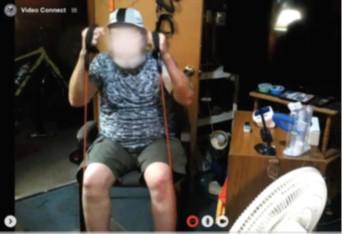
COPD and CHF are a chronic inflammatory lung disease that causes obstructed airflow from the lung and a chronic heart disease that cannot pump blood adequately to the body, respectively. They affect millions of people in the United States, and are leading causes of death. Lifestyle change, disease education, and regular exercise is critical to reduce negative effects of COPD and CHF and improving the quality of life. However, receiving specialty care within the Veteran Affair is challenging since some veterans live in rural area where access is limited. Furthermore, function mobility in patients with COPD and CHF is limited; therefore, regular transport to the clinic is problematic. To improve accessibility of care to veterans, the VA has piloted the use to remote tele-rehabilitation to bring care into home; thus reducing the need to visit the clinic. In this collaborative project, a cardiovascular and pulmonary tele-rehabilitation clinic is setup at the VA medical center in Houston, Texas. Using wearable sensor, we aim to develop objective metrics to measure the improvement of the function performance of patients undergoing the intervention.
Collaborators: Amir Sharafkhaneh, M.D. (PI), Mon S. Bryant, Ph.D., P.T. (PI), Bijan Najafi, Ph.D. (Key Investigator), Christina Nguyen, R.R.T., R.P.S.G.T. (Key Investigator), Gu Kang, Ph.D. (Postdoc), Ilse Ruiz, M.D. (Research Associate)
Therapeutic Plantar Electrical Stimulation Intervention During Hemodialysis to Improve Balance and Mobility

Degrading in balance function and mobility are serious issues in patients with diabetes and end-stage renal disease undergoing hemodialysis process. Studies have shown that electrical stimulation is effective to treat painful and sensory diabetic neuropathy as well as to accelerate wound healing. Our team is collaborating with Hamad Medical Corporation in Doha Qatar to provide electrical stimulation on the plantar region during patient’s regular hemodialysis process. We are exploring the effect of electrical stimulation on improving balance and mobility.
Funding: Qatar National Research Foundation (NPRP10-0208-170400I)
Collaborators:. Bijan Najafi (PI),. Al-Ali Fadwa (PI),. Ram kinker Mishra (Postdoc), Abdullah Hamad,. Talal Talal (DPN), Rania Ibrahim (RN), and Hamad Medical Corporation (Doha-Qatar) .
Improving Rehabilitation and Reducing Re-Occurrence of Diabetic Foot Ulcers
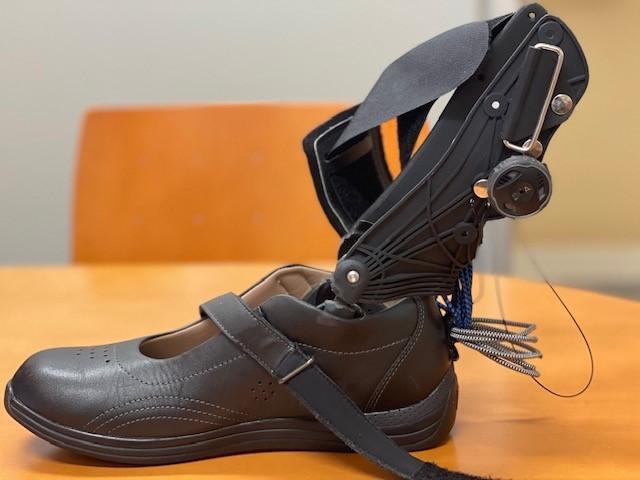
Improving Rehabilitation and Reducing Re-Occurrence of Diabetic Foot Ulcers by Shifting Plantar Pressure with Exo-Tendon & Exo-Skeletal Footwear Systems
The purpose of this study is to design and validate an Exo-skeletal footwear system to prevent ulcer recurrence in people with diabetes.
Funding: Department of Health and Human Services Administration For Community Living (NIDILRR) - 90BISB0011-01-00
Collaborators:. Bijan Najafi (Site-PI), Roser (Contant-PI), Ram Kinker Mishra (Postdoc), Naima Rodriguez (Research Coordinator).
Practical Platform for In-Home Remote Monitoring of Cognitive-Frailty

Frailty is marked by increased vulnerability to external stressor and it is strongly related to a number of adverse outcomes between the geriatric populations. Several literatures show that the early diagnosis of frailty and rapidly performing medical care can improve the outcome. Despite the importance of this screening, there is not any method to remotely assessing and monitoring elderly population. To address these limitations, we are designing a novel platform, which enables measuring parameters of interest via a standard web-cam camera and robust image processing algorithms. We quantify frailty phenotypes including weakness, slowness, rigidity, and exhaustion during a 20-second rapid repetitive elbow flexion and extension task.
Funding: NIH 1R41AG061951-01
Collaborator: Bijan Najafi (PI), Michele York (Co-Investigator), Biosensics LLC.,. Ram kinker Mishra (Postdoc), Anmol Momin (Research Coordinator) . Ilse Torres (Research Coordinator)
MCI ITMT: STTR Phase I- ITMT for Patients with Mild Cognitive Impairment
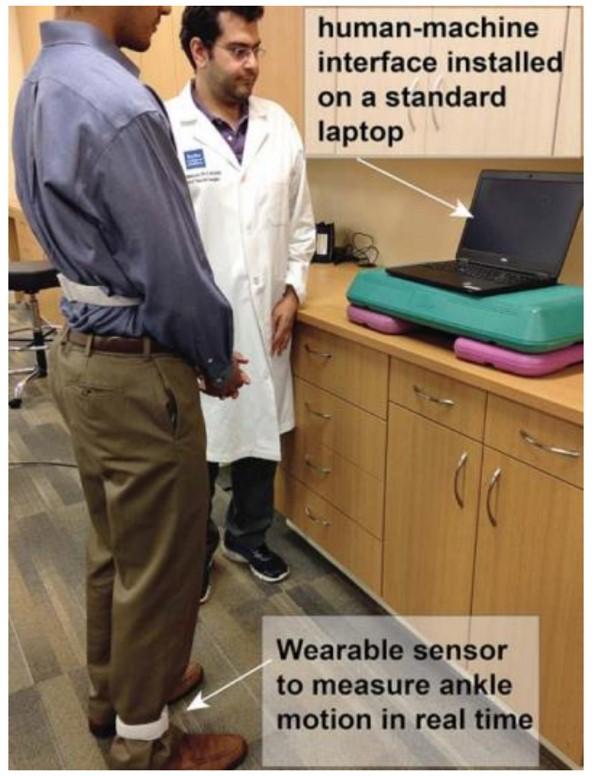
The purpose of this study is to test a new method of looking at cognitive function (e.g. memory, attention, decision-making, etc.) and frailty (physical performance) in older adults. The visits will consist of using wearable sensors that measure gait and balance while performing a series of different tasks. We will be performing a series of health related questionnaires and that assess your activities of daily living. Subjects will also be asked to play a video game during the visit with a sensor that will be attached around your ankle while standing. The task will be to move a small dot into the center of numbered and lettered circles on a computer screen by moving their ankles. We hope this new method could improve the way to help manage dementia and cognitive impairment in older adults.
Collaborators: Bijan Najafi (PI), Ram kinker Mishra (Postdoc), Anmol Momin (research coordinator).
Impact of Diabetic Foot Ulcers and Offloading Footwear on Gait
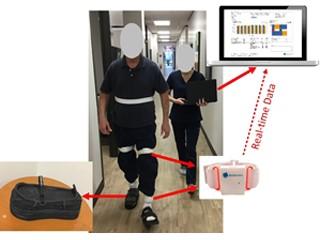
Offloading footwear prescribed to patients with diabetic foot ulcers (DFU) induces a functional leg length discrepancy (LLD). Our team is investigating the negative impact of DFU’s/offloading footwear on gait function. We are also evaluating how prior offloading wear duration affects gait when a contralateral shoe lift is provided.
Instrumented Trail-Making Task: Application of Wearable Sensor to Determine Physical Frailty Phenotypes
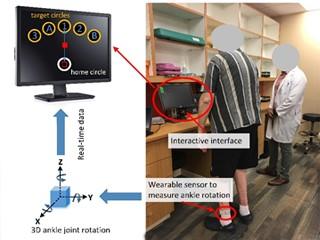
Frailty is a geriatric syndrome that increases an older adult’s vulnerability to falls, hospitalization, long-term care placement, and mortality. Physical frailty assessment tools that are currently available are often time consuming to use with limited feasibility. To address these limitations, our team is developing an instrumented trail-making task (iTMT) platform based on wearable technology to assess physical frailty.
Funding: National Institutes of Health/National Institute on Aging, National Institutes of Health/National Cancer Institute.
Collaborators:. Bijan Najafi (PI), Anand D. Naik, Mark E. Kunik, Javad Razjouyan He Zhou (Postdoc), Debopriyo Halder (Research intern).
Objective Assessment of Physical and Physiological Functions in Youth with Autism Spectrum Disorder and Co-occurring Anxiety
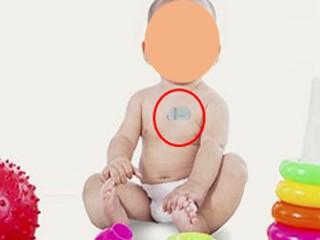
Autism spectrum disorder (ASD) affects approximately 102,000 children younger than 14 years old in the state of Texas only, and among them between 50-80% have anxiety disorders. Behavioral assessments are critical for diagnostic and treatment process for ASD, however the assessments are subjective and objective information is extremely rare. In collaboration among iCAMP, Menninger Department of Psychiatry and Behavioral Sciences at Baylor College of Medicine and Autism Center at Texas Children’s Hospital, the primary goal of this project is to objectively assess physical and physiological functions, circadian rhythm and sleep pattern using wearable sensors in children and adolescents with ASD and anxiety disorders at pre- and post-cognitive behavioral treatment.
Funding: Texas Education Agency
Collaborators: iCAMP ( Bijan Najafi, Gu Kang); Menninger Department of Psychiatry and Behavioral Sciences, Baylor College of Medicine (Eric Storch); Menninger Clinic (Michelle Patriquin); Autism Center, Texas Children’s Hospital (Robin Kochel, Leandra Berry).
Innovative Method for Sensor-Based Frailty Assessment in Survivors of Childhood Cancer
Survivors of childhood cancer are at risk for premature onset of aging-associated health conditions and higher rates of physical impairment than an age-matched general population. The Fried criteria measure physical features of frailty and have been applied to large cohorts of adult survivors of childhood cancer. However, this method is time-consuming and requires specialized training to administer. Alternatively, the upper extremity frailty (UEF) meter leverages sensor technology to rapidly and accurately predict frailty and pre-frailty. The application of this technology has thus far been limited to geriatric populations. In our collaboration with children hospital, we are testing the feasibility of UEF assessment in adolescent and young adult survivors of childhood cancer, and compare mean frailty index (MFI) in survivors to age-matched controls.
Collaborator: Bijan Najafi, Maria M. Gramatges, Mohsen Zahiri, Gu Kang.
Using Wearable Sensor to Measure Propulsion During Walking
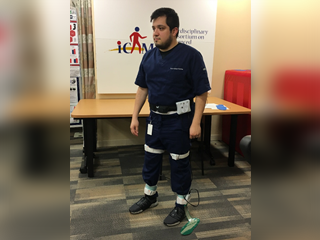
Walking is one of the most common human physical activities. The estimation of the spatio-temporal parameters of walking is helpful to assess the abnormal walking and quantify the progress of the subjects in the intervention studies. Propulsion phase as the step to push off the ground and move the leg forward for the next step plays an important role in the walking period. Despite the importance of this step, there is not any method to detect this phase in the walking period without using force plate. In this study, we aim to define the propulsion phase during walking using wearable sensors.
Collaborator: Bijan Najafi, Mohsen Zahiri.
Evaluation of Chest Abduction for Assessing Risk of Sternal Dehiscence using Wearable Technology
Median sternotomy is a common cardiac surgical approach. Sternal dehiscence is a possible complication after median sternotomy, carrying a significant morbidity and mortality rate of 10-40%. Sternal precaution (including performing activities of daily living in a restricted way to reduce chest abduction) is a universal part of patient discharge education. This study aims to design a telemonitoring platform to identify chest abduction during activities of daily living using flexible wearable sensors for the patients post median sternotomy.
Collaborators: Bijan Najafi (PI), Ravi Kiran Ghanta (PI), Changhong Wang (Postdoc), Rahul Goel (Postdoc), Maria Noun.
Evaluation of Propulsion Performance for Assessing Risk of Diabetic Foot Ulcer (DFU) using Smart Socks Technology
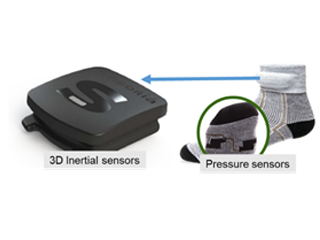
Diabetic foot ulceration is a common comorbidity affecting 25% of patients with diabetes and loss of protective sensation. As we know, the poor propulsion performance could magnify plantar pressure and lower gait speed, which in turn may lead to increasing risk of recurrence of ulcers. This study aims to design a telemonitoring platform to assess DFU risk based on propulsion performance in daily walking using smart socks which can monitor kinematic information and plantar pressure of the feet, and alert the patient with high risk of DFU recurrence to receive above-standard podiatric care.
Funding: Qatar National Research Fund
Collaborators: Bijan Najafi (PI), Talal Talal (PI), Changhong Wang (Postdoc), Rahul Goel (Postdoc).
Using Wearable Technology to Assess Severity of Neurogenic Thoracic Outlet Syndrome in Supervised and Free-living Conditions
Neurogenic thoracic outlet syndrome (nTOS) is a commonly debilitating condition caused by dynamic compression of the brachial plexus in its traverse between the first rib and scalene muscles, resulting in pain and paresthesias of the upper extremity. This study is to define and test feasibility of an upper extremity test to determine severity of nTOS condition using wearable sensors in a supervised environment. Additionally, we will also develop a wearable platform to assess activity intensity of arm movements for determining severity of nTOS condition in free-living environment and tracking the recovery of the nTOS patient after receiving physical therapy or surgery.
Collaborators: Bryan Burt (Contact-PI), Bijan Najafi (PI), Mohsen Zahiri (Postdoc), Changhong Wang (Postdoc).
Track Changes in Risk of Falling, Capture Real-world Falls, & Determine Physical Activities prior to Falls
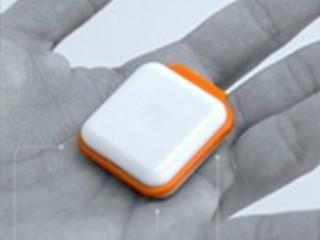
Falls are leading cause of injury in older adults over 65 years of age, accounting for 90% of hip and wrist fractures and 60% of head injuries. Capturing a real fall event and analyzing kinematic information of the body movement during the fall are critical to investigate why a fall occurs and to guide the prevention of falls. This study will use novel wearable telehealth platforms (wearable sensors and tablet) to determine dynamic changes in risk of falling; capture falls automatically, and determine physical activities prior to falls.
Funding: NIH-SB1AG032748
Collaborators: Bijan Najafi (PI), Changhong Wang (Postdoc), Anmol Momin
Wellbuilt for Wellbeing: The Impact of Office Design on Health and Wellbeing
Some 50 million office workers in the United States spend over a fifth of their time in the workplace. Quantifying the health benefits from the improvement of workplace design and air quality at work could foster innovation in office design, which in turn could promote population health. Armed with innovative and practical wearable technologies as well as interdisciplinary collaboration, our team is exploring how office design may impact wellbeing as quantified by physiological stress response, physical activities at work and after work, and sleep quality, all objectively measured using wearable technologies and algorithms designed and validated by our team at iCAMP.
Funding: General Service Administration
Collaborators: GSA, University of Arizona, College of Architecture, Planning & Landscaping, College of Medicine, College of Science Psychology, Institute on Place and Wellbeing, Aclima, Arizona Center for Integrative Medicine, and Center for Business Intelligent and Analytics
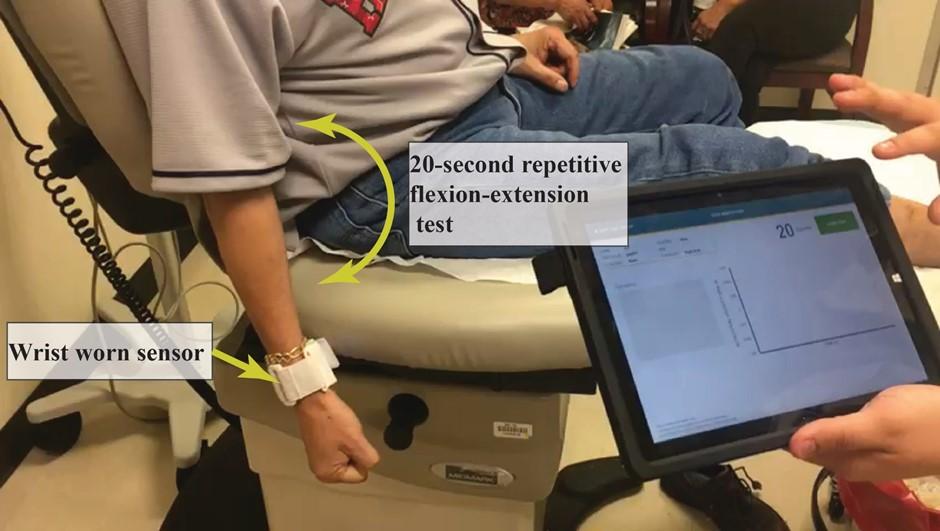
Cognitive and Motor Performance as a Predictor of PAD Vascular Surgical Outcomes
Postoperative assessment of vascular surgery outcomes is critical in clinic operation and health informatics since vascular surgery is associated with high rates of perioperative morbidity and mortality. Moreover, patients who undergo major vascular surgery are at increased risks of myocardial infarction, renal failure, respiratory complications, and death. Accurately identifying which patients are at a high risk of adverse effects or death after major surgery is key for early recognition and treatment of postoperative complications. This study aims to utilize a wearable technology-based system as an objective assessment of frailty for preoperative and postoperative patients to predict post-operational complications, length of hospital stay, and duration of recovery.
Collaborators: Bijan Najafi (PI), Joseph Mills (PI), Miguel Montero (PI), Ramyar Gilani (PI), Simon Hoeglinger (research intern), Vanessa Hinko (research intern), Noreen Siddiqi (research intern), Lauren Bokaie (research intern), Richard Tran (research intern), Hadi Rahemi (Postdoc)
Quantifying the Pep in your Step: Assessing Frailty Status & Gait as Cognitive-Motor Metrics
Primary hyperparathyroidism (PHPT) affects approximately 1 percent of the adult population and is the 3rd most common endocrine disorder in the United States. Parathyroidectomy is the definitive treatment for classical PHPT, which is defined as the presence of symptoms such as osteitis fibrosa cystica, nephrolithiasis, and elevated blood calcium. A vast majority of PHPT patients, 80 percent, present asymptomatically with vague symptoms of the disease such as fatigue, weakness, joint pain, trouble concentrating, and memory impairment. For these asymptomatic PHPT patients, there are no clear guidelines for surgical intervention due to the dearth of objective information on the efficacy of parathyroidectomy in this population. Using wearable sensors, iCAMP designs custom-made algorithms to quantify the motor-cognitive manifestations of PHPT as a method to track outcomes following parathyroidectomy. Using this information, we seek to better understand how parathyroidectomy affects the motor-cognitive impairments experienced by asymptomatic PHPT patients and facilitate the evidence-based clinical decision-making in their plan of care.
Collaborators: Bijan Najafi (PI), James Suliburk (PI), Noreen Siddiqi (research intern), He Zhou (Postdoc), Hadi Rahemi (Postdoc)
Evaluation of Surgical Skills Using Wearable Technology
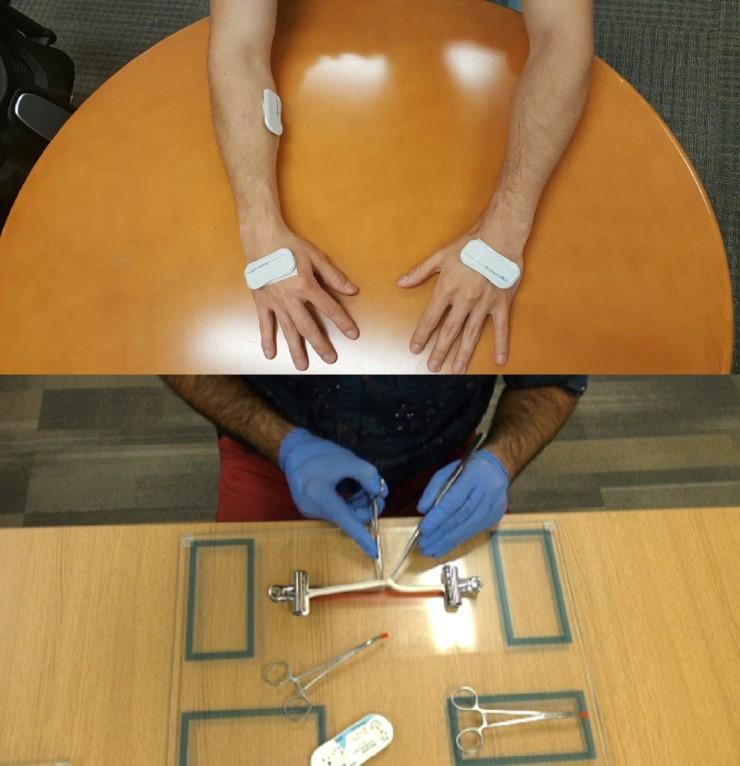
Surgical trainees are challenged with gaining technical proficiency. In recent times, direct observation from attending surgeons remains the primary method of identifying technical proficiency in surgical residents, which is inherently subjective. This challenge has underscored the importance of alternative surgical training techniques outside of the operating room. Hand motion analysis (HMA) is evolving as an objective tool for grading technical dexterity to reduce the possibility of developing poor technique at early stages. However, most devices accompany with technical limitations or discomfort. . Despite, ICAMP has developed a novel method of evaluation through a vascular anastomosis task evaluated with new flexible wearable sensors, which are placed on the dorsum of both surgeon’s hands. Capturing parameters (total distance traveled, total time of task, number of hand movements, mean and peak velocity, ratio of dominant to non-dominant hand movements, and average grip force during the task) among different levels of surgeons can be useful in providing feedback to trainees regarding their progression during residency, and improving their skills.
Collaborators: Ramyar Gilani (PI), Bijan Najafi (PI), Alejandro Zulbaran (Research Assistant), Nestor Arita (Resident), Hadi Rahemi (Postdoc), Javad Razjouyan (Postdoc)
Using Wearable Technology for Predicting Adverse Events and Outcomes Post-LVAD Implantation
Continuous-flow left ventricular assist device (LVAD) has been used increasingly in patients with end-stage heart failure as a destination therapy and as a bridge to heart transplant. Despite improved technologies and patient management strategies, neurologic complications, including stroke, remains a devastating complication during support of LVAD (10-20%). Neurocognitive impairment is frequent in patients with end-stage heart failure with prevalence ranging from 25-75%, and it is thought to be related to poor cerebral perfusion caused by low-cardiac output, low systolic blood pressure, and impaired cerebral autoregulation. Subsequently, impairment of neurocognitive function can lead to increased risk for neurological complications after LVAD implantation. Therefore, accurate assessment of neurocognitive function is crucial for end-stage heart failure patient before LVAD implantation for understanding risk of postoperative neurologic complications. Using iCAMP-developed algorithms, cognitive function and frailty is assessed pre-LVAD implantation and monitored during ICU recovery. Understanding cognitive recovery post-LVAD implantation may help reduce the number of complications in this population.
Collaborators:Bijan Najafi (PI), Masa Ono (PI), Mary Kim (MS1), Arash Hamvatan (Research intern), He Zhou (Postdoc)
An Innovative Virtually Supervised Exercise for Dialysis Patients
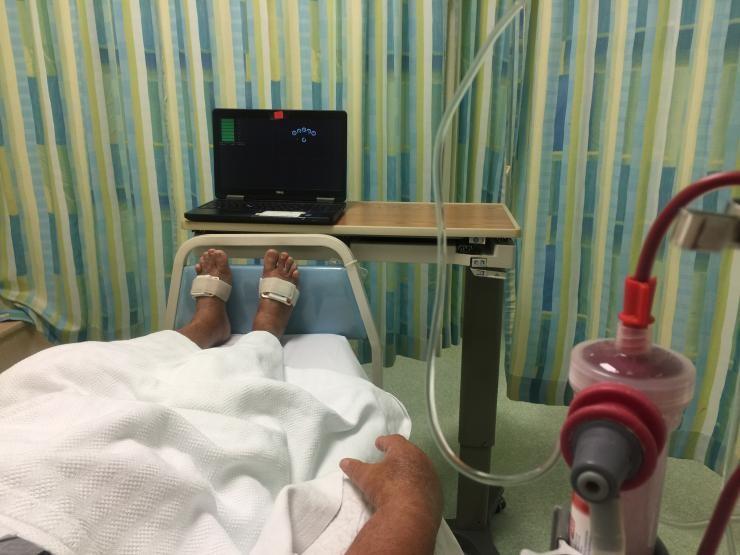
Among patients with diabetes, 35 percent suffer from chronic renal disease and may require dialysis or kidney replacement over time. Furthermore, in diabetics with end-stage renal disease (ESRD) that require dialysis, the risk of foot complications and amputation is even more common, expensive, and devastating. Interestingly, even though the incidence of foot ulcers in patients with dialysis has been reported to be same as with patients with a history of foot ulcers; dialysis patients have significantly higher rate of foot amputation.
The goal of this project is to incorporate an innovative virtually supervised non-weight bearing exercise in patients undergoing dialysis to reduce the risk of fall and foot ulceration by enhancing lower extremity blood flow, joint perception, and joint mobility.
Collaborators: Bijan Najafi (PI), Al-Ali Fadwa (PI), He Zhou (Postdoc), Mona Amirmazaheri (Research intern).
Therapeutic Efficacy of Leukocyte Rich Platelet Rich Plasma (LR-PRP) on Functional Mobility in Primary Knee Osteoarthritis
LR-PRP has become routinely used as a potential therapeutic for knee osteoarthritis, but there still lacks standardization of quantifiable outcome metrics to evaluate functional progress. To date, no studies have specifically evaluated the effect of LR-PRP in knee osteoarthritis using functional mobility battery assessments and validated patient reported outcomes simultaneously. Our team is collaborating with H. Ben Taub Department of Physical Medicine and Rehabilitation at Baylor College of Medicine, and investigating gait and balance functions pre- and post-LR-PRP.
Collaborators: Bijan Najafi (PI), Prathap Jayaram (PI), Gu Kang (Postdoc)
Sleep Study: Assessing Heart Rate Response as a Result of Intervention or Disorder Using Body Worn Sensors

Objective sleep assessment is needed to diagnose sleep disorders. The gold standard, Polysomnography (PSG-medical code 95810 or 95811), consists of an overnight study in a sleep lab in which patients come to a sleep laboratory where multiple channels of data are collected including: measures of total sleep time (TST); sleep efficiency (SE); wake after sleep onset (WASO); sleep architecture; and identification of pathological events, including apneas, hypopneas, and periodic leg movements. Advances in PSG equipment have made the collection of these data in their usual sleeping environment, this is the exception. Whether in the sleep lab or home, the collection of PSG data is invasive, disruptive to sleep, and costly (ranging from $1200 to $8,000 in a recent 2013 assessment).
Actigraphy utilizes a single channel that collects motion data, which is used to infer time spent asleep and wake.
Actigraphy is less invasive, less expensive, and the Actigraphy can be worn for extended periods of time in the natural sleep setting. Actigraphy performed over multiple nights may provide more reliable data on sleep measures than PSG, which is typically performed for only one night. Actigraphy data, usually averaged over several nights, typically includes (TST), (SE), (WASO), information about daytime inactivity, and circadian rhythm data. Many prior studies have compared PSG to Actigraphy. These studies have used different actigraph systems, making direct comparison of devices difficult, as patterns of activity and rest may differ and influence the overall accuracy of specific algorithms for inferring sleep. Population differences in age, gender, and morbidity also influence the accuracy of differing approaches. Sleep duration and quality are important predictors of health outcomes, with growing recognition of the importance of sleep in geriatric populations. It is stated that sleep and sleep quality have profound impact on daily life and quality of life. Sleep, as a part of circadian rhythm, plays an essential role on the general health of elders and is associated with depression. There is a need to identify the optimal approaches for measuring sleep parameters in older populations. Poorer Actigraphy reliability in older adults may be attributable to less activity, which may be misinterpreted as sleep by the wrist-worn Actigraphy, or sleep may be underestimated due to the more frequent nocturnal arousals experienced by elders.
Recent development of body worn sensors has allowed less obtrusive monitoring of sleep, and may provide additional data as they measure activity in three dimensions (three planes: vertical, frontal and lateral), in addition to ECG, and Heart and Respiratory Rate, which are wirelessly transmitted and recorded, and may be readily collected in the natural home setting over a series of days.
Ergonomics: Assessing Heart Rate Response as a Result of Intervention or Disorder Using Body Worn Sensors
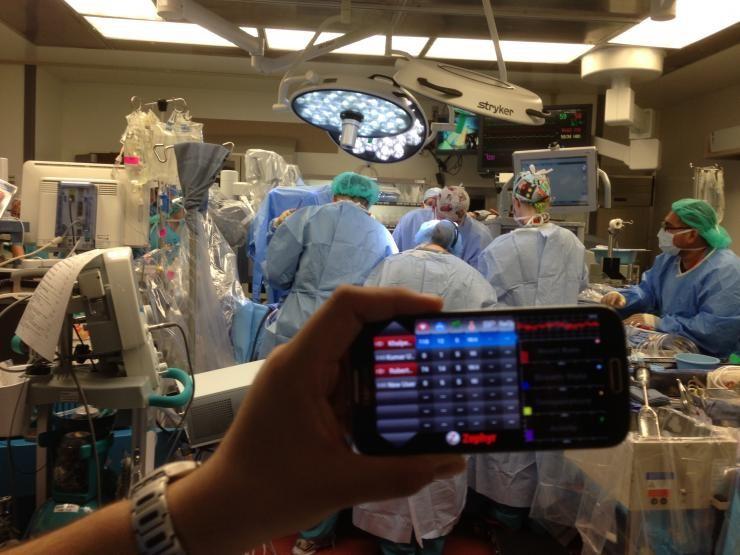
Physical stress associated with fixed-posture of neurosurgeons over extended periods can result in discomfort, fatigue, and musculoskeletal disorders. There are two general factors, an increase in static head and trunk postures and a greater amount of movement required in surgical procedures that contribute to this physical stress. This study is to evaluate the head and trunk motion patterns of neurosurgeons while conducting surgery and to compare the ergonomic variability in movement between skill level of attending and resident surgeons.
Bijan Najafi (PI), Michael Lemole (PI), Christina Walter (Neurosurgery Research Scientist), Changhong Wang (Postdoc), Mohsen Zahiri (postdoc), Hung Nguyen (postdoc), Sanam Sharafkhaneh (student intern)
Stress Analysis in Surgery Resident: Assessing Heart Rate Response as a Result of Intervention or Disorder
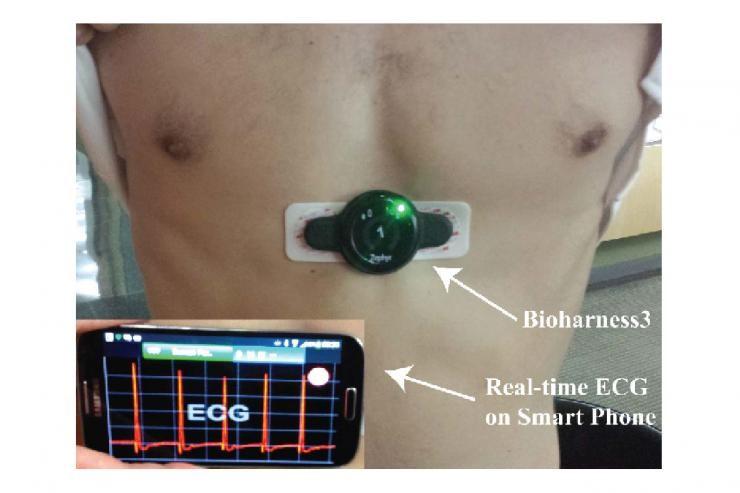
Simulation-based training has gained popularity recently. However, few objective and modifiable parameters that may influence operative performance have been identified. This study proposes the usage of an innovative wearable technology to assess physiological stress response during an intensive laparoscopic training course and examine its association with residents’ operative performance. This study examines the association between residents’ operative performance and spontaneous stress level during an intensive laparoscopic training course. The initial results are promising and may open new avenues for identifying objective and modifiable parameters to improve surgical training.
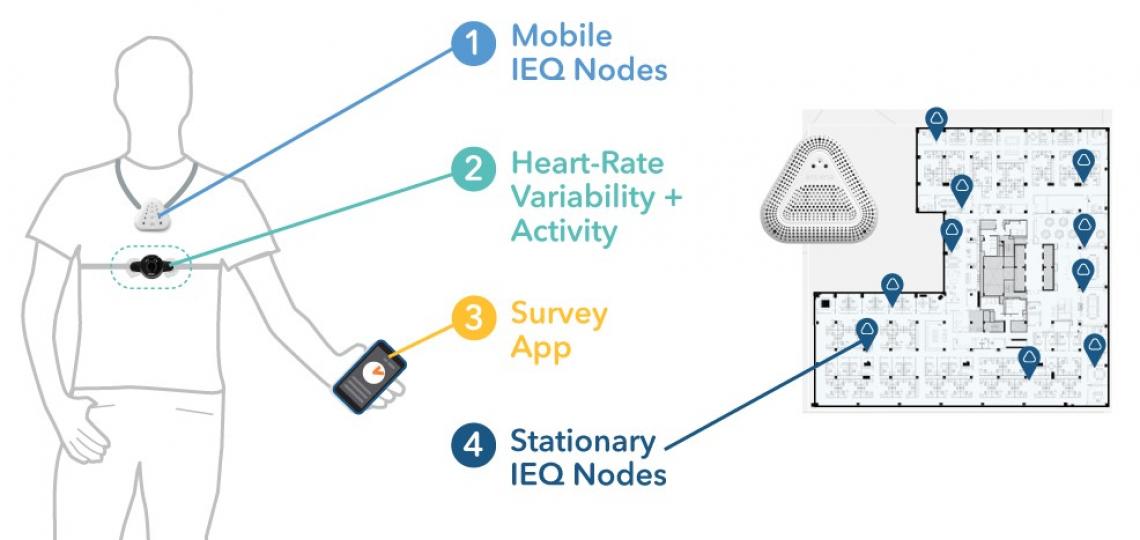
Unobtrusive Physiological Signal Detection During Sedentary Behavior
Since office workers spend three fourth of their working hours sitting, unobtrusive physiological signal detection during sedentary behavior may be beneficial to develop a system for early detection of individual serious physiological distress. Conventional heart rate and respiratory monitoring device is obtrusive, inconvenient or uncomfortable so impractical for long-term monitoring. Although wearable devices are more comfortable than conventional ones, they may lead to a problem related to adherence to wearing sensor. This study aims to present a method for unobtrusive monitoring respiration during sedentary behavior using a smart residential flooring or carpet system. Moreover, this study is the first step for designing smart residential carpet or flooring system, which can screen physical and physiological activities unobtrusively.
Electrical Stimulation as an Adjunctive Therapy To Accelerate Wound Healing In People With Diabetic Foot Ulcers
Electrical stimulation (E-Stim) may offer a unique treatment option to heal complicated and recalcitrant wounds, improve flap and graft survival, and even reduce the likelihood of ulceration. E-Stim has been suggested to reduce infection, improve cellular immunity, increase perfusion, relieve pain, improve plantar sensation, and accelerate wound healing. This therapy could have positive effect on not only increasing skin perfusion in patients with diabetes but also could improve mobility and balance via enhancing plantar sensation. Thus, plantar stimulation not only may be beneficial to accelerate wound healing in diabetic foot ulcer (DFU) patients but also may assist to improve mobility and reduce the likelihood of recurrence of ulcers. Our team evaluated the effectiveness of an innovative portable electrical stimulation platform (Tennant Biomodulator by AVAZZIA Inc.) to accelerate wound healing in DFU patients utilizing novel technologies (e.g. near infrared and three-dimensional cameras). It is hypothesized that 1) electrical stimulation will have an immediate effect on increasing skin perfusion (immediate benefit) and 2) daily use of the Tennant Biomodulator is effective to speed up wound healing, increase skin perfusion, reduce pain, and improve balance and mobility in DFU patients (long term benefit).
Collaborators: Bijan Najafi (PI), Brian Lepow (DPM), Alejandro Zulbaran (Research Assistant), Naima Rodriguez (Research Coordinator)
Comparative Effectiveness of Two Acellular Matrices (Dermacell vs. Integra) for the Management of Deep Diabetic Foot Ulcers
Diabetic Foot Ulcer (DFU) treatment is a dynamic process involving interactions between cells, extracellular matrix (ECM) and growth factors that reconstitutes tissue following injury. ECM plays an important role in tissue regeneration and is the major component of the dermal skin layer. Recognition of the importance of the ECM in wound healing has led to the development of wound products that aim to stimulate or replace the ECM in particular in case of deep tissue destruction because of deep DFUs. These scaffolds include those comprising an intact ECM or individual components of the ECM, and those comprising hybrids incorporating a synthetic component with a biologic component. DermACELL (LifeNet Health,Virginia Beach, VA) is acellular dermal matrices (ADM), which has been shown to be effective in treating chronic DFUs. Another ADM product available in the market is made by Integra® (Bilayer Matrix Wound Dressing, Integra LifeSciences). However, advantages/disadvantages of one compared to the other are unclear. Our team sought to compare the outcomes such as grafts failure, adverse events (e.g. amputation, infection, etc), cost of wound healing treatment, tissue biomechanics, and other patient-centered outcomes (e.g. pain, quality of sleeping, wound smelling, etc). Our team utilized different technologies (e.g. three-dimensional, Near infrared, and thermall cameras) for wound objective evaluation.
Collaborators: Bijan Najafi (PI), Jeffrey Ross (DPM), Brian Lepow (DPM), Alejandro Zulbaran (Research Assistant), Naima Rodriguez (Research Coordinator)
Effectiveness of Continuous Diffusion of Oxygen Adjunct Therapy to Improve Scar Reduction after Anterior Neck Surgery
Dressing materials are known to influence postoperative surgical wound healing and scar formation. A particular dressing that could promote wound hydration is key to ensure quick epithelialization and decrease excessive scar formation. Our team has examined the effectiveness of a novel dressing called TransCu O2 with add-on component of Continuous Diffusion of Oxygen to reduce scar length post-anterior neck surgery either for thyroid or parathyroid disease. Our team utilizes novel technological devices such as near infrared camera for a precise and objective evaluation of scar reduction.
Collaborators: Bijan Najafi (PI) James Suliburk (MD), Alejandro Zulbaran (Research Assistant), Naima Rodriguez (Research Coordinator)
Evaluation of Continuous Diffusion of Oxygen Adjunct Therapy to Improve Success Rate of Lower Extremity Surgically Closed Wound
Specialized wound dressings have the ability to improve specific physiological processes that facilitate healing. However, their specific benefits and target wounds is not well understood. Consequently, these are either underutilized in clinical practice or over utilized without any well-defined criteria. TransCu O2 Continuous Diffusion of Oxygen delivery system is a novel wound healing therapy that promises to enhance vascular conditions at the wound bed and expediting wound healing and might reduce the likelihood of adverse event such as excessive necrotic tissue, dehiscence/open wound, and surgical revision among patients with diabetes and lower extremity surgical wound closure. Our team utilizes novel technological devices such as near infrared camera for a precise and objective evaluation of wound healing. The body of work in this area suggests opportunities for better patient care using a simple, inexpensive approach that has few adverse effects.
Collaborators: Bijan Najafi (PI), Jeffrey Ross (DPM), Brian Lepow (DPM), Alejandro Zulbaran (Research Assistant), Naima Rodriguez (Research Coordinator)
Physical and Cognitive Exercise for Older Adults
This cross sectional research is to determine if there are difference in gait and frailty measure across the cognitive spectrum between elder groups of “Health,” “Mild Cognitive Impairment (MCI),” and “Alzheimer’s.” By comparing with the traditional paper-based cognitive trail marking test, we plan to show that the participant can benefit much more by using wearable inertial sensors and real-time visual feedback based motorial-cognitive exercises.

STTR Phase I: Smart Residential Carpet for Promoting Aging in Place
The continuing growth of senior citizen population will bring significant financial and logistical burdens on the nation’s healthcare system. Instead of going to a nursing home or older adults living community, aging in place, enabling senior citizens to continue safely and economically living in their own residences as long as possible, is becoming more and more critical. Aging in place is a promising solution to alleviate financial and logistical burdens on the nation’s healthcare system as well as provide the senior citizen a happy and healthy life. However, currently aging in place is still facing several challenges: in-home detection or prevention of fall and frailty which are clinically crucial because those are major health conditions associated with aging and may cause an increase in delirium, disability, hospitalization, long-term care and death.
To ensure safe and secure aging in place, this project aims to design and commercialize a novel smart carpet system for tele-activity monitoring which not only can track gradual changes in gait and motor performance but also can recognize an emergency circumstance in order to manage the health in senior citizens in unsupervised condition when the risk of falls and frailty are becoming increasingly significant. The proposed technology will have a significant positive impact because it: 1) focuses on aging in place to promote quality of life and alleviate the healthcare costs in senior citizens; 2) focuses on an essential public health issues—risk of falls and frailty—in senior citizens; 3) aims to reduce the possibility of injuries and death in senior citizens using tele-monitoring technique; and 4) provides an objective tool appropriate for context-aware system for successful aging in place in senior citizens.
Using Body-Worn Sensors to Determine the Effect of Stress on Wound Healing in the Diabetic Foot
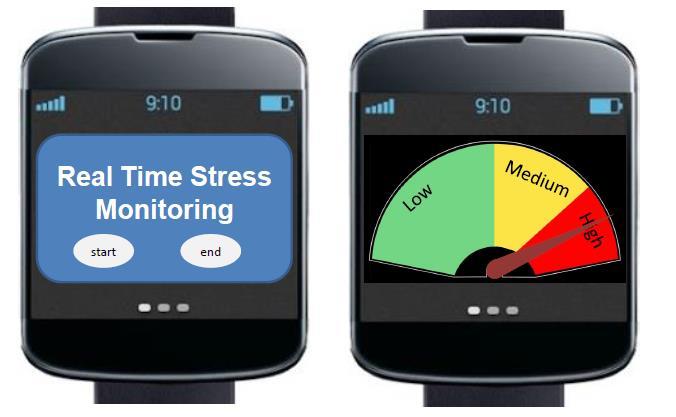
Excessive wound healing times are a significant risk factor that may lead to amputation of the diabetic foot. To date, objective measures of stress have not been used to determine if stress affects the rate at which wounds heal. Our study used novel real-time monitoring of patient’s heart rate variability to objectively determine stress levels of patients visiting a surgery clinic for wound dressing changes. Wound healing rates of patients with high stress levels were compared to healing rates of low-stress individuals to determine how stress affects wound healing among diabetics.
Postoperative Outcome Management
Assessing postoperative outcome after major pulmonary resection, such as lobectomy or pneumonectomy, is essential in clinic operation and health informatics since the major thoracic surgical procedures are associated with high morbidity and mortality rate. Moreover, patients with lung cancer who undergo a surgery experience greater fatigability, a reduction in exercise tolerance, muscle weakness and compromised quality of life as a direct consequence of their disease or as an indirect consequence of their cancer therapy. This project aims to design a wearable technology-based system for pre-operational and post-operational management of postoperative outcomes in patients who undergo lung surgery, which is able to not only assess pre-operative fragility, length of hospital stay and duration of recovery from surgical procedures but also pre-operative conditioning.
Managing Chemotherapy Induced Neuropathy in Cancer Patients Using Exergaming (R21)

Falls are a considerable health concern for older adults, including people with cancer. The Centers for Disease Control report that falls are the leading cause of injury and death. People who receive chemotherapy for cancer are more likely to fall compared to people who do not receive cancer treatment. Problems associated with cancer including anemia, fatigue, pain, and reduced functional status may contribute to fall risk. One of the major risk factors for falls in cancer patients is chemotherapy induced peripheral neuropathy (CIPN). CIPN is a dose limiting side effect of many important classes of chemotherapeutic agents, such as taxanes, platinum-based drugs, vinca alkaloids, proteasome inhibitors, and others. Although the incidence of CIPN varies among exposure to drug class, approximately 30-40 percent of cancer patients are affected by CIPN. Loss of balance (57%), muscle weakness (57 percent) or lack of coordination (14 percent) are major self-reported symptoms in patients with CIPN. Among different CIPN-related symptoms loss of balance and walking difficulty have been identified as the leading risk factors for falls.
The innovating proposed research project is using validated wearable technology for objectively assessing CIPN-related balance and gait deficits and estimating fall risk and improving balance and gait performance using Exergaming including sensor-based feedback from lower extremity joint movement and position. The interactive and game features in particular could be beneficial for cancer survivors, who often suffer from cancer-associated fatigue and depression and thus may require specific exercise strategies such as game-based training to foster adherence to home-based exercises.
Effectiveness of Ankle-foot orthoses for fall prevention
Foot problems are prevalent in older adults, which may increase the risk and concern for falls. Ankle-foot orthoses (AFO) have been shown to be effective in the stabilization of lower extremities, but their long-term effectiveness in improving balance and their potential to encourage older adults to become more physically active are still debated. This randomized controlled trial investigated the effectiveness of daily use of a custom-made AFO on balance, fear of falling, physical activity, and falls in older adults.
Contributors: Bijan Najafi (PI), Brian Lepow, Jeffrey Ross, Changhong Wang (postdoc), Rahul Goel (postdoc)
Mobility performance assessment for chemotherapy decisions
Accurate performance status (PS) assessment is important for chemotherapy decisions throughout the illness trajectory, but current tools to assess PS are subjective, static and prone to inter-observer and recall biases. Wearable activity monitors may provide both an objective and dynamic digital biomarker of PS. This was a feasibility study to compare ECOG PS to postural and walking data from a PAMSys monitor, a triaxial accelerometer, in patients receiving chemotherapy.
Contributors: Bijan Najafi (PI), Yvonne Hsiao-Fan Sada (PI), Sudha Yarlagadda (postdoc), Changhong Wang (postdoc), Jinna Chu (student intern)
AVEX FootBeat-Micro Mobile Foot Compression Device for Reducing Lower Extremity Edema in Patients with Diabetes
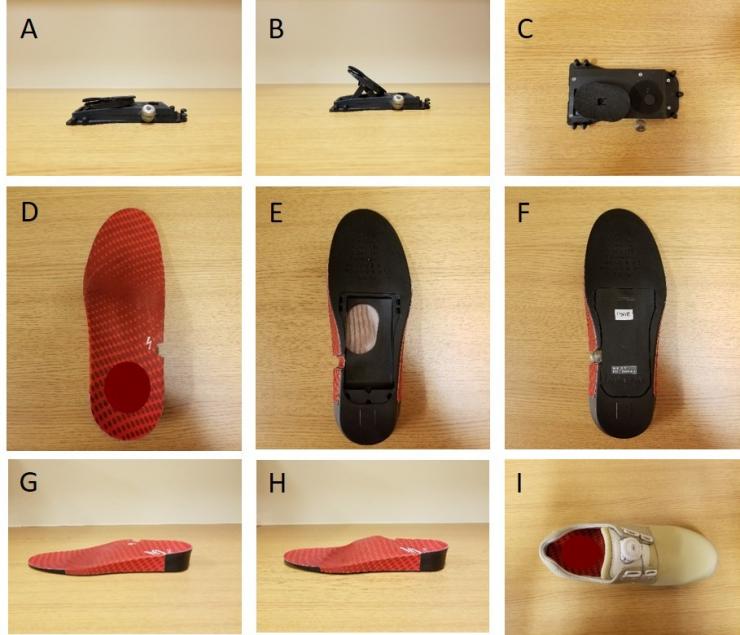
Diabetic foot ulceration (DFU) is a common and largely preventable complication of diabetes. While most of these ulcers can be treated successfully, some will persist and become infected. Ultimately, nearly one fifth of patients with infected lower-extremity diabetic ulcers will require amputation of the affected limb, resulting in staggering costs for both the patient and the healthcare system.
This area has received comparatively little attention from industry, academia, and insurance providers. AVEX Health has designed a novel low voltage, battery powered medical device to assist in the treatment of Diabetic Foot Ulcers. This device is portable and can be used in ambulatory settings providing increased venous blood flow and relief from concomitant lower extremity edema. Additionally, AVEX has teamed up with Boa Technology to incorporate an innovative shoe tightening device named ‘Clutch Reel’ which could enhance the ease of wearing diabetic shoes and provide the right amount of compression at lower extremities with minimal skin friction.
AVEX foot compression device can help improve lower extremity perfusion, whilst improving balance and spatio-temporal parameters of gait. In addition, we aim to assess the effectiveness of the Boa Technology ‘Clutch Reel’ at producing pre-set shoe tightening tension while enhancing the ease of wearing diabetic shoes with the AVEX insole and Clutch Reel, reducing skin friction, and improving patient’s confidence in their gait, mobility, balance, and daily physical activities.
Osteoarthritis Initiative (OAI)
Osteoarthritis affects more than 27 million individuals in the United States. The NIH has long supported research to improve outcomes for patients with this debilitating disease. Knee osteoarthritis is associated with significant pain and development of disability over time. People who are severely compromised have few effective treatment options other than joint replacement. There are differences in the prevalence, incidence and severity of osteoarthritis between men and women and among races. Currently, there are no disease-modifying agents for the treatment of osteoarthritis. The discovery of osteoarthritis biomarkers—including structural characteristics that can be observed with MRI—could lead to identification of new treatment targets and mechanisms for shorter, more efficient trials of disease-modifying agents.
The Osteoarthritis Initiative (OAI) is a multicenter, longitudinal, prospective, observational study of knee osteoarthritis (OA) that was launched by NIH in 2002. The overall aim of the OAI is to develop a public-domain research resource to facilitate the scientific evaluation of biomarkers for osteoarthritis as potential surrogate endpoints for disease onset and progression. The goals of the OAI were to enroll approximately 5,000 subjects with risk factors for early knee osteoarthritis, and to collect clinical and imaging data and biological specimens from these participants for originally four, and now eight years of follow up.
Portable Device for Telecare Monitoring of Elderly People (Funded by NIH/NIA STTR Phase IIB)
As baby boomers age, and their expected life span increases, the number of U.S. elders aged 65 and over will dramatically rise, producing unprecedented need for effective, low cost diagnosis, treatment and monitoring of home and community-dwelling elders. This study aims to develop and commercialize a novel wearable technology for activity monitoring of elders using a single and easily wearable sensor. The proposed technology allows remote and continuous clinimetrically relevant screening of elder’s risk of falling as well as early detection and targeted intervention of those at risk of frailty.
Managing Chemotherapy Induced Neuropathy in Cancer Patients Using Exergaming (Funded by NIH/NCI)
Cancer patients suffering from chemotherapy-induced peripheral neuropathy (CIPN) have a significantly higher risk of falling than their peers due to insensitivity in the lower extremities causing deficits in keeping balance during standing and walking; however, appropriate exercise training programs for these patients have not been developed. Conventional fall prevention training may not be well suited for these patients because 1) the exercises may be too difficult; and 2) many existing exercises do not incorporate visual feedback, which is critical, given the impaired proprioception associated with peripheral neuropathy.
We propose to evaluate a system consisting of three wearable movement sensors and software that provides visual feedback of lower extremity position in a game-based, motivational, virtual environment to facilitate performance of specific exercises in cancer patients exposed to neurotoxic chemotherapy to mitigate CIPN-induced balance problems and increased fall risk.
Massive Weight Loss and Its Effect on Postural Stability and Fall Risks (Funded by NIH/NIAMS –R03)
Critical gap exists in how massive weight loss impacts postural stability and fall risks in obese adults with knee osteoarthritis (OA). Persistence of this gap delays reducing fall risks and improving motor function. The long-term goals are to create innovative interventions that minimize fall risks and to develop new methods of detecting fall risks in this population. The objective of the proposed study is to test if massive weight loss after bariatric surgery in adults with knee OA is sufficient to improve key factors contributing to postural instability and fall risks: knee pain, atypical gait, and a decreased ability to control the center of mass (COM). Despite the known effects of obesity on postural stability, we know little about if adults who have massive weight loss improve postural stability based on spatial-temporal gait and COM measures. There is also limited evidence on if improvements in postural stability occur on flat ground and tasks beyond flat ground walking. Most importantly, there are few objective measures after bariatric surgery related to activities outside of the lab. The proposed research is significant because it can lead to a new science focused on quantification, detection, and intervention.








 Credit
Credit
